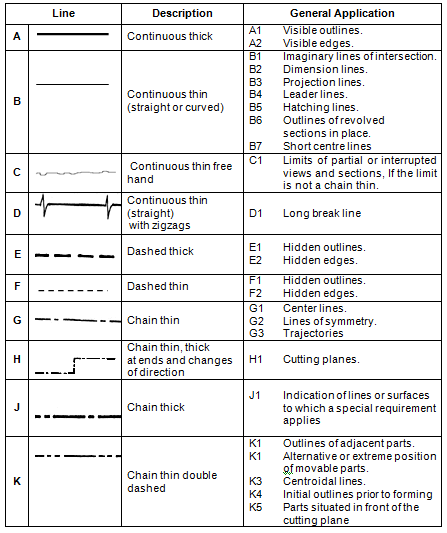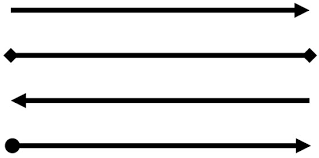A Line Must Be a Single Continuous Shape
Lines in Technical Drawings:
We have various type of lines in technical drawings and geometric constructions. Each of these lines will serve a different purpose by providing a specific detail or information to those looking at your construction or drawing.
As a student, an understanding of the various type of lines will prove generally useful, especially to those with great interest in Mathematics and Basic Technology. Also, those who are into buildings (building engineers) will need to read and interpret various architectural drawings in order to effectively implement their job.
In Technical Drawings, lines are used for the interpretation of drawings by the technical people involved.
Various type of lines are often used as a form of language communication between technical individuals.
You can read on lines in mathematics here.
Type of Lines
The diagram below shows the various types of line, their description and general application:

1. Thin Continuous Line
________________
A thin continuous line could be a straight or curved line but the main point to remember is this: 'it is a tiny (thin) line with no dot or dashes within it'.
A Thin Continuous Line is used for representing the followings:
- Projection lines
- Hatching lines
- Construction lines
- Short center lines
- Measurement lines
- Diagonal lines used to state plane surfaces
- Intersections
- Leader lines
- Backside section lines
2. Thick Continuous Line
________________
It has a stronger outline than the thin continuous line. It could be straight or curved, but with no dot or dashes within it.
Thick Continuous Line is mainly used for:
- Representing visible outline and edges.
- Surrounding the sides that matter in technical drawings.
You can attempt Len Academy basic technology questions for JSS2, 2nd term here.
3. Short/Thin Dash Lines
-----------------------
These lines contain short tiny (thin) dashes within it.
Short Thin Dash Lines are used for:
- Representing hidden details and edges on an object.
- Representing hidden outlines.
4. Dashed Thin Lines with Dots
Below are the uses of Dashed Thin Lines with Dots:
- They are used for center lines.
- They are used as line of symmetry.
- They serve as axis lines of symmetrical drawings.
5. Dashed Thin Lines with Double Dots
This line is similar to the Dash Thin Lines with Dots except that it has double dots within it.
- It is used for ghost outlines and bend.
6. Arrowhead Lines

They are lines with pointed edges at one or both ends. The pointed edges are in the form of an arrow.
Arrowhead Lines are used:
- At the end of dimensional lines.
- As measurement lines.
You can check out some interesting facts for students here.
7. Continuous Thin Straight Zigzag Line
This is a straight line in the zigzag direction. Please see the diagram above.
Below are the uses of Continuous Thin Straight Zigzag Line:
- They are used for representing long break lines.
- They are used for limits of partial views if the limit is not an axis.
- They are used for limits of interrupted sections if the limit is not an axis.
8. Free Hand Line
These lines are drawn only with the hands and without a ruler or another similar ruling material.
Note: The Free Hand Line is similar in function to the Continuous Thin Irregular Line.
The Free Hand Line serves the following:
- Limits partial views.
- Interrupts views and sections.
- Used as the limit to an interrupted view when an axis is not present.
9. Chain Thin Line with Thick Ends
Please see the diagram above
- They are used on cutting planes.
Need more answers to this topic? Please enter your search below:
-
Please click here to support Len Academy
Kindly share this article via the links below:

Please contact Alfred via the above whatsapp link for a comprehensive online academic coaching in Biology, Chemistry, Basic Science and ICT
Click here to read the amazing features of the Len Academy Smart School Software. However, contact Alfred through the above whatsapp link if you require a standard website for your business or school at an affordable price
Please click here to follow Len Academy on Google News.
Please like and follow our official facebook page here for great educational write-ups.
You can follow Len Academy on twitter here.Thank you.
Please Register here or Login here to contribute to this topic by commenting in the box below.
Source: https://www.len.com.ng/csblogdetail/318/Type-of-Lines-in-Technical-Drawings
0 Response to "A Line Must Be a Single Continuous Shape"
Post a Comment